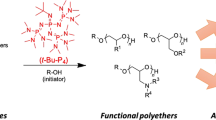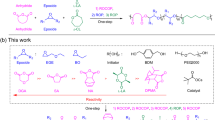Abstract
We report the facile synthesis of sequence-defined, uniform oligo(ester-amide-ester)s, and periodic poly(ester-amide-ester)s composed of ɑ-hydroxy acids and ɑ-amino acids. The synthetic strategy for preparing the oligomers involves two sequential steps with bromoacetic acid and potassium isocyanoacetate as the key building blocks. (1) The first step is a nucleophilic substitution reaction between a bromoacetic ester and potassium isocyanoacetate to generate a new isocyanoacetic ester, (2) and the second is a Passerini reaction of the formed isocyanoacetic ester with an aldehyde and bromoacetic acid to form a longer bromoacetic ester with an ester-amide linkage and a side-group originating from the aldehyde. Repeating this cycle affords sequence-defined uniform oligo(ester-amide-ester)s with different side groups. This strategy efficiently provides uniform, symmetrical oligo(ester-amide-ester)s via an iterative approach. Furthermore, two strategies were examined to obtain sequence-defined periodic poly(ester-amide-ester)s through the polycondensation of different oligomers. The polycondensation based on the nucleophilic substitution of α,ω-bromo carboxylic acids as the oligomer was less effective, while the DIC/DPTS-mediated polycondensation of α,ω-hydroxy carboxylic acids as the sequence-defined oligomer was efficient enough to afford high-molecular-weight periodic poly(ester-amide-ester)s.
This is a preview of subscription content, access via your institution
Access options
Subscribe to this journal
Receive 12 print issues and online access
$259.00 per year
only $21.58 per issue
Buy this article
- Purchase on Springer Link
- Instant access to full article PDF
Prices may be subject to local taxes which are calculated during checkout









Similar content being viewed by others
References
Lutz JF, Lehn JM, Meijer EW, Matyjaszewski K. From precision polymers to complex materials and systems. Nat Rev Mater. 2016;1:16204.
Lutz JF, Ouchi M, Liu DR, Sawamoto M. Sequence-controlled polymers. Science. 2013;341:1238149.
Lutz JF. Defining the field of sequence-controlled polymers. Macromol Rapid Commun. 2017;38:12.
Ouchi M, Sawamoto M. Sequence-controlled polymers via reversible-deactivation radical polymerization. Polym J. 2018;50:83–94.
Solleder SC, Schneider RV, Wetzel KS, Boukis AC, Meier MAR. Recent progress in the design of monodisperse, sequence-defined macromolecules. Macromol Rapid Commun. 2017;38:1600711.
Soejima T, Satoh K, Kamigaito M. J Main-chain and side-chain sequence-regulated vinyl copolymers by iterative atom transfer radical additions and 1:1 or 2:1 alternating radical copolymerization. Am Chem Soc. 2016;138:944–54.
Grate JW, Mo KF, Daily MD. Triazine-based sequence-defined polymers with side-chain diversity and backbone-backbone interaction motifs. Angew Chem Inter Ed. 2016;55:3925–30.
Hibi Y, Ouchi M, Sawamoto M. A strategy for sequence control in vinyl polymers via iterative controlled radical cyclization. Nat Commun. 2016;7:11064.
Wu YH, Zhang J, Du FS, Li ZC. Dual sequence control of uniform macromolecules through consecutive single addition by selective passerini reaction. ACS Macro Lett. 2017;6:1398–403.
Ji YX, Zhang LQ, Gu X, Zhang W, Zhou NC, Zhang ZB, et al. Sequence-controlled polymers with furan-protected maleimide as a latent monomer. Angew Chem Inter Ed. 2017;56:2328–33.
Kametani Y, Sawamoto M, Ouchi M. Control of the alternating sequence for N-Isopropylacrylamide (NIPAM) and methacrylic acid units in a copolymer by cyclopolymerization and transformation of the cyclopendant group. Angew Chem Inter Ed. 2018;57:10905–9.
Nowalk JA, Fang C, Short AL, Weiss RM, Swisher JH, Liu P, et al. Sequence-controlled polymers through entropy-driven ring-opening metathesis polymerization: theory, molecular weight control, and monomer design. J Am Chem Soc. 2019;141:5741–52.
Li J, Stayshich RM, Meyer TY. Exploiting sequence to control the hydrolysis behavior of biodegradable PLGA copolymers. J Am Chem Soc. 2011;133:6910–3.
Schmidt B, Fechler N, Falkenhagen J, Lutz JF. Controlled folding of synthetic polymer chains through the formation of positionable covalent bridges. Nat Chem. 2011;3:234–8.
Altintas O, Barner-Kowollik C. Single chain folding of synthetic polymers by covalent and non-covalent interactions: current status and future perspectives. Macromol Rapid Commun. 2012;33:958–71.
Rosales AM, Segalman RA, Zuckermann RN. Polypeptoids: a model system to study the effect of monomer sequence on polymer properties and self-assembly. Soft Matter. 2013;9:8400–14.
Nielsen PE. Peptide nucleic acid. a molecule with two identities. Acc Chem Res. 1999;32:624–30.
Horne WS, Gellman SH. Foldamers with heterogeneous backbones. Acc Chem Res. 2008;41:1399–408.
Fonseca AC, Gil MH, Simões PN. Biodegradable poly(ester amide)s - a remarkable opportunity for the biomedical area: review on the synthesis, characterization and applications. Prog Polym Sci. 2014;39:1291–311.
Basu A, Kunduru KR, Katzhendler J, Domb AJ. Poly(α-hydroxy acid)s and Poly(α-hydroxy acid-co-α-amino acid)s derived from amino acid. Adv Drug Deliv Rev. 2016;107:82–96.
Winnacker M, Rieger B. Poly(ester amide)s: recent insights into synthesis, stability and biomedical applications. Polym Chem. 2016;7:7039–46.
Shi CX, Guo YT, Wu YH, Li ZY, Wang YZ, Du FS, et al. Synthesis and controlled organobase-catalyzed ring-opening polymerization of morpholine-2,5-dione derivatives and monomer recovery by acid-catalyzed degradation of the polymers. Macromolecules. 2019;52:4260–9.
Llevot A, Boukis AC, Oelmann S, Wetzel K, Meier MAR. An update on isocyanide-based multicomponent reactions in polymer science. Top Curr Chem. 2017;375:66.
Koopmanschap G, Ruijter E, Orru RVA. Isocyanide-based multicomponent reactions towards cyclic constrained peptidomimetics. Beilstein J Org Chem. 2014;10:544–98.
Bonne D, Dekhane M, Zhu JP. Mild oxidative one-carbon homologation of aldehyde to amide. J Am Chem Soc. 2005;127:6926–7.
Moore JS, Stupp SI. Room-temperature polyesterification. Macromolecules. 1990;23:65–70.
Pirrung MC, Das Sarma K. Aqueous medium effects on multi-component reactions. Tetrahedron. 2005;61:11456–72.
Sravan Kumar J, Jonnalagadda SC, Mereddy VR. An Efficient Boric acid-mediated preparation of α-hydroxyamides. Tetrahedron Lett. 2010;51:779–82.
Stayshich RM, Meyer TY. New insights into Poly(lactic-co-glycolic acid) microstructure: using repeating sequence copolymers to decipher complex NMR and thermal behavior. J Am Chem Soc. 2010;132:10920–34.
Acknowledgements
This work was supported in part by the National Natural Science Foundation of China (Nos 21534001 and 21871014).
Author information
Authors and Affiliations
Corresponding authors
Ethics declarations
Conflict of interest
The author declares that he has no conflict of interest.
Additional information
Publisher’s note Springer Nature remains neutral with regard to jurisdictional claims in published maps and institutional affiliations.
Supplementary information
Rights and permissions
About this article
Cite this article
Wang, YZ., Wang, JC., Wu, YH. et al. Sequence-defined oligo/poly(ester-amide-ester)s via an orthogonal nucleophilic substitution reaction and a Passerini reaction. Polym J 52, 133–143 (2020). https://doi.org/10.1038/s41428-019-0272-6
Received:
Revised:
Accepted:
Published:
Issue Date:
DOI: https://doi.org/10.1038/s41428-019-0272-6



